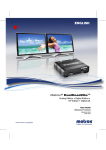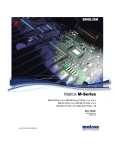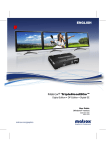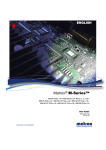Download Matrox PJ-4OLP User guide
Transcript
ENGLISH Matrox solutions for medical imaging Matrox MED Series MED2mp-DVI • MED3mp-DVI • MED4mp-DVI • MED5mp-DVI • MED5mp User Guide 10856-301-0200 2006.08.24 www.matrox.com/graphics Contents Overview ...................................................................................................................3 Hardware supplied....................................................................................................................................3 Software supplied......................................................................................................................................4 Installation overview.................................................................................................................................4 Hardware installation ...............................................................................................5 Connection setup.....................................................................................................8 MED-DVI connection setup ....................................................................................................................8 MED4mp-DVI connection setup ..........................................................................................................10 MED5mp connection setup ...................................................................................................................11 Software setup ......................................................................................................12 Display setup..........................................................................................................13 Accessing PowerDesk..............................................................................................................................13 Monitor setup .........................................................................................................................................13 Portrait monitor setup............................................................................................................................15 Multi-display setup .................................................................................................................................16 Grayscale setup........................................................................................................................................16 More PowerDesk information................................................................................................................17 Troubleshooting......................................................................................................18 Basic procedures .....................................................................................................................................18 Main troubleshooting.............................................................................................................................18 Extra troubleshooting.............................................................................................................................24 Product information ...............................................................................................34 More information ....................................................................................................40 Warranty .................................................................................................................41 Software license agreement ..................................................................................43 Index .......................................................................................................................44 2 Matrox MED Series – User Guide Overview Providing high image quality, sharp grayscale and color output, your Matrox MED Series card is designed to meet the needs of the medical imaging market. This product can be used for a range of medical applications, including PACS (Picture Archiving and Communication Systems), X-ray imaging, MRI (Magnetic Resonance Imaging), and digital radiography. MED Series cards support resolutions (in either portrait or landscape orientations) up to 1920 × 1200 for the MED2mp, 2048 × 1536 for the MED3mp, 2560 × 1600 for the MED4mp, and 2560 × 2048 for the MED5mp. Hardware supplied MED2mp-DVI, MED3mp-DVI, MED4mp-DVI, and MED5mp-DVI Matrox card (PCI card shown) DVI-to-HD15 adapter * * For more information, see page 8. MED5mp (3W3) Matrox card (PCI) 2 monitor cables * * For more information, see page 11. Matrox MED Series – User Guide 3 Software supplied ! Matrox PowerDesk – to use your Matrox product ! Other software – see the CD-ROM Readme file Installation overview Note: If your Matrox product is already partially or fully installed on your computer, some or all the installation information in this guide may not apply to you. However, this information may be useful if you need to reinstall your Matrox product. To install your Matrox product: 4 1 Install the Matrox card – see “Hardware installation”, page 5. 2 Connect your monitors – see “Connection setup”, page 8. 3 Install the software – see “Software setup”, page 12. 4 Set up the software – see “Display setup”, page 13. Matrox MED Series – User Guide Hardware installation This section describes how to install your Matrox card. If your Matrox card is already installed in your computer, skip to “Connection setup”, page 8. For information specific to your computer, like how to remove its cover, see your system manual. WARNING: To avoid personal injury, turn off your computer, unplug it, and then wait for it to cool before you touch any of its internal parts. Also, static electricity can severely damage electronic parts. Before touching any electronic parts, drain static electricity from your body (for example, by touching the metal frame of your computer). When handling a card, carefully hold it by its edges and avoid touching its circuitry. 1 Open your computer and remove your existing graphics card * a Using Add/Remove Programs in the Windows Control Panel, remove any currently installed display drivers. Restart your computer for the changes to take effect. After your computer restarts, you’re prompted to install drivers for the new graphics hardware detected. Click Cancel. b Turn off your computer and all peripherals such as your monitor or printer. c Open the computer and remove your existing graphics card. (If graphics hardware is built into the motherboard of your computer, this graphics hardware should automatically disable itself after your Matrox card is installed. For more information, see your system manual.) * With multi-display mode, you may be able to use your existing graphics card. For more information, see Windows online help under “Multiple Display Support”. Matrox MED Series – User Guide 5 2 Choose an expansion slot Most computers have different types of expansion slots. Choose an AGP or PCI (not PCI Express) slot, depending on the type of Matrox card you have. If you have a PCI card, your card supports both 64-bit and 32bit PCI slots. Your system manual should identify the location of each type of expansion slot in your computer. (Back of computer) AGP slot PCI Express slots (×16) (×1) PCI slots (64-bit) (32-bit) Note: If you’re using a PCI graphics card in a 64-bit compatible slot, your choice of PCI slot may affect your card or system performance. For more information, see your computer manual. WARNING: Inserting your Matrox card into the wrong type of slot could damage your card, your computer, or both. If you have a PCI card and you’re using a 32-bit PCI slot, only part of your card’s edge connector (the part closest to the bracket) should be inserted into the PCI slot. AGP card 32-bit 64-bit PCI card 3 6 Insert your Matrox card a Position your Matrox card over the expansion slot you’ve chosen. b Push the card in firmly and evenly until it’s fully seated in the slot. c Secure the bracket of your Matrox card to the computer frame. Matrox MED Series – User Guide Your Matrox card is now installed. Before restarting your computer, connect your monitor or monitors (see “Connection setup”, page 8). After connecting, restart your computer and install your Matrox software (see “Software setup”, page 12). WARNING: If your computer doesn’t restart after your Matrox card is installed, turn off your computer to avoid damaging electronic parts. For troubleshooting information, see page 18. Matrox MED Series – User Guide 7 Connection setup This section describes how to connect monitors to different models of Matrox MED Series cards. WARNING: Don’t change monitor connections while your computer is turned on. While your computer is turned on, it may be using monitor settings that are specific to the current monitor connections. Some devices may be permanently damaged if incorrect settings are used. Note: Whenever you change your connection setup, make sure you’re using the correct connectors and that all connectors are properly fastened. Note: The left-to-right order of your displays isn’t dependent on your connection setup and, through Matrox PowerDesk software, you can re-order your displays to match your Windows desktop. For more information, see Matrox PowerDesk help. MED-DVI connection setup The following describes how to connect monitors to a Matrox MED Series card that has DVI connectors. For information on how to connect your MED4mpDVI product, see “MED4mp-DVI connection setup”, page 10. Note: To connect a digital monitor (a monitor that uses digital input, usually a flat panel monitor) to your Matrox product, your monitor must have a DVI connector. HD-15 connector (analog) Some monitors with DVI connectors support both digital and analog input. If DVI connector DVI connector you’re using one of these monitors with (analog/digital) (digital) your Matrox product, make sure it’s configured to use the correct type of input. For more information, see your monitor documentation. 8 Matrox MED Series – User Guide 1 Connect the first monitor Connect your preferred monitor to the main connector (A) on your Matrox card. Monitor connector (DVI) If your monitor has a DVI connector, connect it directly to the main connector of your card. If your monitor has an HD-15 connector, use the DVI-to-HD15 adapter included with your product to connect your monitor to the main connector. DVI-to-HD15 adapter Monitor connector (HD-15) 2 Connect the second monitor Monitor connector (DVI) If your second monitor has a DVI connector, connect it directly to the secondary connector (B) of your card. If your monitor has an HD-15 connector, use a DVI-to-HD15 adapter to connect your monitor to the secondary connector. If you need a second DVI-to-HD15 adapter, contact your computer vendor. DVI-to-HD-15 Monitor connector (HD-15) Note: Whenever you restart your computer, make sure your monitors are already turned on. Otherwise, the software may not be able to properly detect your monitors. Matrox MED Series – User Guide 9 MED4mp-DVI connection setup The following describes how to connect monitors to a Matrox MED4mp-DVI card. This card is designed for DualLink monitors. Note: The main connector (A) of your Matrox product is designed for use with a DualLink monitor. The secondary connector (B) is for an optional analog monitor. 1 Connect your DualLink monitor Using the cable included with your DualLink monitor, connect this monitor to the main connector (A) of your Matrox card. 2 DualLink cable Connect an analog monitor (optional) If your analog monitor has a DVI connector, connect it directly to the secondary connector (B) of your card. If your analog monitor has an HD-15 connector, use the DVI-to-HD15 adapter included with your Matrox product to connect your monitor to the secondary connector. 10 Matrox MED Series – User Guide DVI-to-HD15 adapter Monitor connector MED5mp connection setup The following describes how to connect grayscale monitors to a Matrox MED5mp card. This card is designed for grayscale monitors with BNC (Bayonet Neill-Concelman) connectors. WARNING: Depending on your Matrox product, the output signal is configured to use 50 or 75 ohms. Before connecting a monitor to your Matrox card, make sure they’re compatible. Otherwise, some monitors may be permanently damaged. For more information, see your monitor documentation. 1 Connect the first monitor Connect one of the monitor cables included with your Matrox product to the main connector (A) on your Matrox card. Monitor cable (included) Connect the BNC connectors on your monitor cable to your preferred monitor. 2 Connect the second monitor Connect your other monitor cable to the secondary connector (B) on your Matrox card. Connect the BNC connectors on your monitor cable to your second monitor. Note: When connecting the BNC connectors on your monitor cable to your monitors, make sure the Green (G), Horizontal Sync (H – gray wire), and Vertical Sync (V – black wire) connections are firmly in place and plugged into the correct input. Matrox MED Series – User Guide 11 Software setup Note: This guide has references that are specific to the Matrox installation CD-ROM. If your Matrox product wasn’t packaged by Matrox (for example, if it was included with your computer), your product may not include this CD-ROM. If you don’t have this CD-ROM, certain references in this guide may not reflect the software you have. For more information, see other software documentation provided by your system vendor. This section describes how to install Matrox software for Windows 2000/XP or NT 4.0. You may need administrator rights to install certain software. For more information, see Windows documentation. 1 Install display driver If you’re using Windows 2000/XP, it detects new hardware when you restart. If Matrox display drivers haven’t been previously installed, Windows prompts you to install a display driver. Follow the on-screen instructions. (The Matrox Windows 2000/XP display driver is in the Win2kXP folder of your Matrox installation CD-ROM.) 2 Install optional software After your computer restarts, you may install additional software from the Matrox Installation CD-ROM. You can simply browse the Installation CD-ROM for the program you want to install, then you can run the installation program in that folder. 3 Set up your display software See “Display setup”, page 13. 12 Matrox MED Series – User Guide Display setup Windows 2000/XP or NT 4.0 – Your Matrox display driver includes Matrox PowerDesk software. This software helps you get the most out of your Matrox card. This section has important information on how to configure your display settings using Matrox PowerDesk software. Accessing PowerDesk Many display controls are available through Matrox PowerDesk. To access Matrox PowerDesk: ! Windows 2000/XP – Right-click your Windows desktop background, then click Properties " Settings " Advanced " PowerDesk " Matrox PowerDesk-HF. ! Windows NT 4.0 – Click Start " Settings " Control Panel " Matrox Display Properties (double-click). Also, to quickly access PowerDesk features, double-click the Matrox PowerDesk (Windows 2000/XP) or Matrox QuickDesk (Windows NT 4.0) icon ( ) on your Windows taskbar. To see the PowerDesk icon in Windows XP, you may need to click the Show hidden icons button ( ) on your Windows taskbar. Note: Multi-display mode is supported under Windows 2000/XP and NT 4.0. For more information on multi-display mode, see Windows 2000/XP online help under “Multiple Display support”. Monitor setup Before changing your display resolution, color palette, or other Matrox PowerDesk settings, make sure correct software monitor settings are selected. If you have a Plug-and-Play (DDC) monitor, correct settings are usually automatically selected. The following explains how to make sure your monitor settings are okay. WARNING: If you’re using BNC connectors with a Plug-and-Play monitor, the Plug-andPlay feature of your monitor can’t be used. WARNING: If incorrect software monitor settings are applied, some monitors can be permanently damaged. For more information, see your monitor manual. Matrox MED Series – User Guide 13 Windows 2000/XP – If you have a Plug-and-Play (DDC) monitor, Windows should automatically use correct settings for your monitor. To make sure the correct monitor is selected in Windows: 1 Right-click your Windows desktop background, then click Properties " Settings " Advanced " Monitor. If you’re using a multi-display desktop (see “Multi-display setup”, page 16), select a display before clicking Advanced. 2 If the monitor name listed isn’t Plug-and-Play and doesn’t match your monitor, click Properties " Driver " Update driver. Follow the on-screen instructions. 3 If you’re using a multi-display desktop (see “Multi-display setup”, page 16), repeat steps 1–2 for each display in your Windows desktop. For more information on Windows monitor settings, see Windows documentation. If you want to customize your Windows monitor settings: 1 From the main interface of PowerDesk (see “Accessing PowerDesk”, page 13), click Monitor Adjustments. 2 Select the appropriate device. 3 Click Adjust visible area and refresh rate. Windows NT 4.0 – 1 Access the PowerDesk Monitor property sheet (see “Accessing PowerDesk”, page 13). 2 If you have a Plug-and-Play monitor: Make sure the Plug-and-Play (DDC) monitor button is selected. If so, the Matrox display driver automatically uses correct settings for your monitor. If not, click this button, then click Apply. If you don’t have a Plug-and-Play monitor: See if the Default monitor (60 Hz) button is selected. If so, use the Matrox monitor selection method. For more information on Matrox monitor selection, see Matrox PowerDesk online documentation. 3 If you’re using a multi-display desktop (see “Multi-display setup”, page 16), repeat steps 1–2 for each display in your Windows desktop. 14 Matrox MED Series – User Guide Portrait monitor setup Most standard monitors are landscape monitors – that is, they’re wider than tall. Portrait monitors are taller than wide. Different models of portrait monitors may have different types of support for this orientation. Some portrait monitors support portrait mode by rotating the monitor signal and reporting support for portrait display resolutions to the graphics hardware. For most monitors, the display resolutions supported are automatically detected and used by the Matrox display driver. Note: A monitor using BNC connectors can’t report its capabilities to the display driver. If your monitor supports both portrait and landscape orientations, it may have one connector for landscape mode and one for portrait mode. Which connector you use determines whether portrait or landscape mode is used. For more information, see your monitor documentation. Before changing your connection setup, always shut down your computer. Some portrait monitors are merely landscape monitors physically rotated 90 degrees. These monitors don’t rotate the monitor signal and don’t report support for portrait resolutions. In this case, use Matrox software to rotate the display to match the monitor orientation. To rotate your display with Matrox software: Windows 2000/XP – 1 From the main interface of PowerDesk (see “Accessing PowerDesk”, page 13), click Monitor Adjustments. 2 Select the appropriate monitor, then click Adjust orientation. 3 If you’re using multiple displays in stretched mode and you want to re-orient your displays as if they were one display, enable Rotate as a single display. 4 Using the arrow buttons, re-orient your display, then click OK. Windows NT 4.0 – 1 Access the PowerDesk Rotate property sheet (see “Accessing PowerDesk”, page 13). 2 If you’re using multiple displays and you want to re-orient your displays as if they were one display, enable Rotate as one display. 3 Using the arrow buttons, re-orient your display, then click OK. Matrox MED Series – User Guide 15 Multi-display setup To set up multi-display mode: Windows 2000/XP – 1 From the main interface of PowerDesk (see “Accessing PowerDesk”, page 13), click Multi-Display Setup. 2 Select the number of displays and the multi-display setup you want to use. 3 Click OK or Apply for your changes to take effect. You may be prompted to restart your computer. Windows NT 4.0 – 1 Access the PowerDesk Settings property sheet (see “Accessing PowerDesk”, page 13). 2 If you want to use multi-display mode, click Multi-Display Desktop ( 3 Change the setup of your multi-display desktop by moving the Desktop area slider, then click OK. ). Note: In multi-display mode under Windows NT 4.0, the same display settings (resolution and grayscale settings) are used for each display. Grayscale setup Windows 2000/XP or NT 4.0 – To select the grayscale setup for your displays: 1 Windows 2000/XP – From the main interface of PowerDesk (see “Accessing PowerDesk”, page 13), click Grayscale Setup. Windows NT 4.0 – Access the PowerDesk Gray Palette property sheet (see “Accessing PowerDesk”, page 13). 2 Select the grayscale setup you want. For more information, see Matrox PowerDesk help. 3 Click OK or Apply for your changes to take effect. You may be prompted to restart your computer. Note: With your Matrox MED-DVI product, DICOM-compliant grayscale output is intended primarily for digital monitors. For analog monitors, the accuracy and consistency of the grayscale output is dependent on your monitor and its calibration. 16 Matrox MED Series – User Guide More PowerDesk information For more information on Matrox PowerDesk: Windows 2000/XP – For PowerDesk online help, click Help " PowerDesk guide from the main interface of PowerDesk (see “Accessing PowerDesk”, page 13). Window NT 4.0 – For context-sensitive help where available, click the “ ” icon in the title bar, then click the item you want help on. Right-click a help topic for a pop-up menu that lets you print or copy it. (Some help topics are only available through context-sensitive help.) ! Access the Matrox PowerDesk Information property sheet (see “Accessing PowerDesk”, page 13). ! Click the Matrox QuickDesk icon ( ) on your Windows taskbar, then click Help " PowerDesk Guide or Help " View Readme File. Matrox MED Series – User Guide 17 Troubleshooting Basic procedures This section explains basic procedures that are referred to by some troubleshooting items in this guide. Restarting in VGA mode Note: If information isn’t properly displayed before Windows starts or while Windows is using VGA mode, you may need a special software update for the BIOS of your Matrox card. For more information, contact the vendor of your Matrox product. Windows 2000/XP or NT 4.0 – What follows is information on how to restart your computer in VGA mode. 1 Restart your computer. # Windows 2000/XP – Click Start " Shut Down " Restart " OK*. (* Depending on your version and configuration of Windows, this part of the step may not be necessary.) # Windows NT 4.0 – Click Start " Shut Down " Restart your computer " Yes. If your primary monitor is unusable, see your system manual for information on how to restart your computer using a hardware control. 2 Windows 2000/XP – Before Windows starts, press [F8] for the Windows startup menu to appear. (If [F8] doesn’t work, instead try pressing and holding [Ctrl] before Windows starts.) 3 Select “VGA mode”, then press [Enter]. Main troubleshooting This section addresses possible problems that could prevent you from using your computer. Problem 1Cause Computer doesn’t display information or boot after Matrox card is installed Your Matrox card may not be properly installed. 18 Matrox MED Series – User Guide 1Solution 2Cause Make sure your Matrox card is properly installed. Specifically, make sure the card is firmly inserted in its expansion slot and that all connections to it are firmly in place. For more information, see “Hardware installation”, page 5. There may be unsupported graphics hardware in your computer. (For Matrox multi-display mode in Windows NT, all graphics cards in your computer must be Matrox cards supported by the display driver.) 1Solution If an unsupported graphics card is plugged into an expansion slot, remove it. 2Solution If graphics hardware is built into your computer motherboard, your system may not have automatically disabled it when you inserted your Matrox card. Check your system manual for instructions on how to disable your computer’s built-in graphics hardware. 3Cause Your computer BIOS (Basic Input/Output System) settings may be incorrect. 1Solution Change your BIOS settings, specifically the AGP aperture size. For more information on your computer BIOS, see your system manual. 4Cause Your computer BIOS may not be up to date. For more information on your computer BIOS, see your system manual. 1Solution Reinstall your previous graphics card and, if possible, update your computer BIOS. This can usually be done with software from the manufacturer of your computer. Contact your system vendor or manufacturer to get a BIOS update for your computer. To get the correct BIOS update, you may need to know the serial number your computer displays when it restarts. (This number is usually in the lower-left corner of the display.) 5Cause 1Solution The BIOS of your Matrox card may need to be updated or restored. Windows 2000/XP or NT 4.0 – For advanced users – If you have another VGA-compatible graphics card (PCI), you can try resetting the BIOS of your Matrox card. 1 Turn off your computer and insert the other graphics card into an expansion slot. For more information on expansion slots, see “Choose an expansion slot”, page 6. Matrox MED Series – User Guide 19 2 Plug your monitor into the other graphics card and restart your computer. Note: Make sure your computer uses the other graphics card to control your primary display. The graphics card that controls your primary display is the one that first displays information when you restart your computer. (A DualHead-supporting graphics card may display this startup information on both of its displays at the same time.) Your computer BIOS (Basic Input/Output System) and the slot type (AGP, PCI, or PCIe – see “Choose an expansion slot”, page 6) of each graphics card help determine which graphics card controls your primary display. To control which graphics card is used for your primary display, you may be able to change the configuration of your computer BIOS. For information on how to change your computer BIOS settings, see your system manual. 6Cause 3 Insert your Matrox installation CD-ROM. 4 Click Start " Run, type d:\SysUtils. You will need to use the PBIOSWin program to update the BIOS of your Matrox card. For more information on how to use this program, see the Readme file in the Sysutils folder. 5 Turn off your computer, remove the other graphics card, then plug your monitor into your Matrox card. 6 Restart your computer. The power supply of your computer may not be powerful enough for all the devices on your computer. 1Solution For advanced users – Remove unnecessary devices from your computer (for example, an unused network card or an extra CD-ROM drive). For more information, see your system manual or the documentation for each device. 2Solution You may be able to upgrade the power supply of your computer. We recommend a power supply of 300 Watts or more. For more information, contact your computer vendor. Problem Wrong color balance, screen image off-center, or no picture at all 1Cause 1Solution Your monitor video controls may be improperly set. Adjust your monitor controls (brightness, contrast, and so on). For more information, see your monitor manual. 20 Matrox MED Series – User Guide 2Cause Your monitor may not be properly connected. 1Solution Make sure you’re using the correct connectors (see “Connection setup”, page 8) and that all connectors are properly fastened. 2Solution Make sure the monitor power cable is firmly in place. 3Solution Make sure the connection to the back of the monitor is firmly in place. If your monitor uses BNC input, make sure the Red (R), Green (G), Blue (B), Horizontal Sync (HSYNC – white or gray wire), and Vertical Sync (VSYNC – black wire) connections are firmly in place and plugged into the correct input. BNC connectors Note: For most analog grayscale monitors using BNC connectors, not all BNC connectors are needed. In most cases, only the Green (G), Horizontal Sync (H), and Vertical Sync (V) connectors are used. 3Cause 1Solution 4Cause 1Solution If your monitor uses BNC input, one or more connection settings may be incorrect. Make sure the input signal supported by your monitor is compatible with the output signal of your Matrox card. For most devices, the signals are configured to use 75 ohms. For some devices (for example, some analog grayscale monitors or some Matrox MED5mp cards), the signals are configured to use 50 ohms. For more information, see your product specifications. If display problems occur after the startup screen of your operating system, your software monitor settings may be incorrect. Make sure correct software monitor settings are selected. If your primary display is still usable, see “Monitor setup”, page 13. Otherwise, see the next troubleshooting item. 2Solution Windows 2000/XP – Make sure you’re not using inappropriate monitor setting customizations: 1 Double-click the PowerDesk icon ( ) on your Windows taskbar to access the PowerDesk main interface. To see the PowerDesk icon in Windows XP, you may need to click the Show hidden icons button ( ) on your Windows taskbar. 2 Click Monitor Adjustments. 3 Select the appropriate device. 4 Click Adjust visible area and refresh rate " Restore defaults. Matrox MED Series – User Guide 21 5Cause 1Solution 6Cause You may be using a grayscale setup that doesn’t conform to the DICOM standard. Make sure you’re using either a fixed linear or a fixed non-linear gray palette. For more information, see Matrox PowerDesk help. Your monitor may not be properly calibrated. 1Solution Make sure your monitor is calibrated for the gray palette you’re using. Problem After the startup screen, or after display settings are changed, the screen image is garbled or unusable (blank screen, rolling or overlapping screen images) 1Cause The Matrox display driver may be trying to use settings your monitor doesn’t support. This can happen if a monitor was never selected in the software and the display resolution was changed to one your monitor doesn’t support, or if the monitor connected to your computer was changed without changing it in the software. WARNING: If incorrect software monitor settings are applied, some monitors can be permanently damaged. For more information, see your monitor manual. 1Solution Windows 2000/XP – 1 If your primary display is unusable, restart your computer in VGA mode (see “Restarting in VGA mode”, page 18). 2 Right-click the Windows desktop background, then click Properties " Settings. 3 Move the Screen area (Windows 2000) or Screen resolution (Windows XP) slider down to its lowest setting, then click OK. 4 Restart your computer normally. 5 Make sure the correct monitor is selected in Windows (see “Monitor setup”, page 13). 6 Restore your original display settings (see steps 2 and 3). Windows NT 4.0 – 1 If your primary display is unusable, restart your computer in VGA mode (see “Restarting in VGA mode”, page 18). 2 Right-click the Windows desktop background, then click Properties " Settings. Windows may prompt you that the display settings are incorrect for the current mode; click OK to continue. 3 Move the Desktop area slider down to its lowest setting, then click OK. 22 Matrox MED Series – User Guide 2Cause 1Solution 4 Restart your computer normally. 5 Select a monitor with the Matrox PowerDesk Monitor property sheet, then adjust your display settings. For more information, see the Matrox PowerDesk online documentation. Files on your system may have been deleted or corrupted. Remove, then restore Matrox software: Note: Before removing software, make sure you have all the necessary files to reinstall software that may still be needed. Note: Windows 2000/XP – You may need administrator rights to remove certain software. For more information, see Windows documentation. Windows 2000/XP or NT 4.0 – 1 If your primary display is unusable, restart your computer in VGA mode (see “Restarting in VGA mode”, page 18). 2 To remove Matrox software: 3 # Windows 2000/XP – Click Start " Settings* " Control Panel " Add/Remove Programs (double-click*) " Matrox PowerDesk-HF and Driver " Change/Remove " Yes. (* Depending on your version and configuration of Windows, this part of the step may not be necessary.) # Windows NT 4.0 – Click Settings " Control Panel " Add/Remove Programs (double-click) " Install/Uninstall " Matrox Graphics Software (remove only) " Add/Remove " Yes. Restart your computer for changes to take effect. After your computer has restarted, install the latest display driver for your Matrox card. You may also need to reinstall other Matrox software. Matrox MED Series – User Guide 23 Extra troubleshooting The following are extra troubleshooting items related to cards. Problem 1Cause 1Solution Windows XP ‘Screen resolution’ slider is disabled While using 256 shades of gray, your Matrox product supports only 8-bit display modes. With these display modes, Windows XP disables the Screen resolution slider. To change the screen resolution of your displays: 1 Right-click your Windows desktop background, then click Properties " Settings. 2 If you’re using a multi-display desktop, select a display. 3 Click Advanced " Adapter " List all modes, select a resolution and refresh rate for your display, then click OK " OK " OK. 2Solution If possible, use 1024 shades of gray. For more information, see Matrox PowerDesk help. Problem Icons and other standard Windows graphics appear incorrectly 1Cause You may be using 256 shades of gray with a Fixed linear gray palette. 1Solution If possible, use 256 shades of gray with a Fixed non-linear gray palette or use 1024 shades of gray. For more information, see Matrox PowerDesk help. 2Cause Windows XP – While using 256 shades of gray, your Matrox product supports only 8-bit display modes. With these display modes, Windows uses only standard Windows colors (16 basic colors plus 4 reserved colors) for icons and other standard Windows graphics. 1Solution Don’t use the Windows XP themes. To change your Windows appearance, right-click your Windows desktop background, click Properties " Themes, select Windows Classic under Theme, then click OK. 24 Matrox MED Series – User Guide Problem 1Cause Can’t select one or more display resolutions supported by your monitor Windows 2000/XP or NT 4.0 – Windows may be disabling display resolutions that it can’t detect as supported by your monitor. 1Solution Install the latest monitor software from your monitor manufacturer. 2Solution Change Windows monitor settings: Problem 1 Right-click your Windows desktop background, then click Properties " Settings. 2 If you’re using a multi-display desktop, select a display. 3 Click Advanced " Monitor, disable Hide modes that this monitor cannot display, then click OK " OK. Can’t use Windows, Windows reports a configuration error, and/or can’t install or uninstall Matrox display driver Note: Windows 2000/XP or NT 4.0 – You may need administrator rights to install certain software. For more information, see Windows documentation. 1Cause 1Solution 2Cause The problem may be specific to the motherboard in your computer. There may be a software update available for your motherboard. To find out what motherboard model your computer is using, see your system manual. For more information, contact the maker of your motherboard or computer. Many motherboard or computer manufacturers have software updates available on their Web site. Files on your system may have been deleted or corrupted. 1Solution Remove, then restore Matrox software. For more information, see page 23. Problem Monitor settings aren’t automatically detected WARNING: If incorrect software monitor settings are used, your display may become unusable and some monitors can be permanently damaged. For more information, see your monitor manual. Matrox MED Series – User Guide 25 Note: Windows 2000/XP or NT 4.0 – To check if your monitor settings are properly selected: 1 Windows 2000/XP – Right-click your Windows desktop background, then click Properties " Settings " Advanced " Monitor. If you’re using multi-display mode, select a display before clicking Advanced. Windows NT 4.0 – Access the Matrox PowerDesk Monitor property sheet (see “Accessing PowerDesk”, page 13). If you’re using multi-display mode, select a display number. 2 If you see the name of your monitor or “Plug-and-Play”, your monitor settings are properly selected. If you see the wrong monitor name or Default monitor, your monitor settings aren’t properly selected. 1Cause Your monitor may not be Plug-and-Play. Most new monitors are Plug-and-Play but many older ones aren’t. Software can’t automatically detect settings for monitors that aren’t Plugand-Play. 1Solution Manually select your monitor settings in the software. For more information, see “Monitor setup”, page 13. 2Cause If a monitor was changed or added while Windows was running, the new monitor may not be detected by the software. 1Solution 3Cause Restart your computer. If your monitor is a Plug-and-Play (DDC) monitor, it should be automatically detected by the software. You may be using BNC connectors with a Plugand-Play monitor. The Plug-and-Play feature of a monitor can’t be used with BNC connectors. BNC connectors 26 Matrox MED Series – User Guide Problem 1Cause 3D and video programs don’t work Your computer may not have given an IRQ (interrupt request) to your Matrox card or may have given one used by another device in your computer. This may be because your computer’s “Plug-and-Play” feature is turned off. Windows 2000/XP – To check the display adapter’s IRQ: 1Solution 1 Click Start " Settings* " Control Panel " Performance and Maintenance* " System (double-click*) " Hardware " Device Manager. (* Depending on your version and configuration of Windows, this part of the step may not be necessary.) 2 Click the plus sign to the left of the Display adapters. An “X” through an icon means the hardware has been disabled. A circled exclamation point through the icon means the hardware has a problem. 3 Double-click the name of your Matrox display adapter to open a properties dialog box. The type of problem is displayed in the General tab " Device status area. Check also the Resources tab " Resource type list for an Interrupt Request. Change settings in your computer BIOS setup utility. If your computer has the options of enabling Plug-and-Play detection, or assigning an IRQ to a VGA adapter, make sure they’re enabled. If your computer doesn’t have these options, you may be able to manually assign an IRQ to your Matrox card using the BIOS setup utility. For more information on the BIOS setup utility of your computer, see your system manual or contact your system manufacturer. 2Cause 1Solution Your computer’s other BIOS settings may be incorrect. Reset your computer BIOS settings to the factory defaults using your computer’s built-in BIOS setup utility. The factory defaults are usually the “safest” settings. Check your system manual for more information. Matrox MED Series – User Guide 27 Problem 1Cause Using multiple displays under Windows 2000/XP or NT 4.0, program doesn’t work with main graphics card Your main graphics card may not be controlling your primary display. The graphics card that controls your primary display is the one that first displays information when you restart your computer. A program that doesn’t recognize multiple displays may not work with a graphics card unless it’s controlling your primary display. Your computer BIOS (Basic Input/Output System) and the slot type (AGP, PCI, or PCIe – see “Choose an expansion slot”, page 6) of each graphics card help determine which graphics card controls your primary display. 1Solution If you’re having problems with a program that can be moved on your Windows desktop, run this program on your primary display. Make sure the program window doesn’t overlap any other display. If the program doesn’t work with the graphics card controlling your primary display, or you want your main graphics card to control your primary display, see the other solutions. 2Solution Change the configuration of your computer BIOS so that the slot type of your main graphics card has priority for becoming the primary display. For information on how to change your computer BIOS settings, see your system manual. If your computer BIOS doesn’t let you select which slot type has priority for becoming the primary display, a BIOS update may be available to let you do this. (The BIOS of most computers can be updated with software.) For a possible BIOS update for your computer, contact your system vendor. 3Solution If there’s a graphics controller built into the motherboard of your computer, by changing your computer BIOS settings, you may be able to change which device controls your primary display. For more information, see your system manual. 4Solution If you don’t need to use the graphics card that’s controlling your primary display, remove it from your computer. If your primary display is controlled by the motherboard of your computer, see your system manual for information on how to disable this graphics controller. 2Cause The program you’re using may not work properly with systems using more than one display at a time. 1Solution An update may be available for the program you’re using. This update may fix problems this program has with multi-display systems. For more information, contact the software distributor for the program you’re using. 2Solution If you’re using multiple displays in independent mode, try using stretched mode instead. Programs that don’t work in independent mode may work in stretched mode. For more information, see Matrox PowerDesk help. 28 Matrox MED Series – User Guide 3Solution Windows 2000/XP – For advanced users – To use a program that doesn’t support multidisplay systems, you can disable all displays other than your primary display: 1 Double-click the PowerDesk icon ( ) on your Windows taskbar to access the PowerDesk main interface. To see the PowerDesk icon in Windows XP, you may need to click the Show hidden icons button ( ) on your Windows taskbar. 2 Click Multi-Display Setup. Make sure you’re using 1 display. 3 Click Start " Settings* " Control Panel " Performance and Maintenance* " System (double-click*) " Hardware " Device Manager. (* Depending on your version and configuration of Windows, this part of the step may not be necessary.) 4 Click the plus sign to the left of the Display adapters. 5 For each display adapter, except for the one controlling your primary display, right-click the name of a display adapter, then click Disable " Yes. Note: Your primary display can’t be disabled. 6 Restart your computer for changes to take effect. Note: To restore display adapters, repeat steps 3–5, but click Enable in step 5. Problem Not all graphics cards in the computer are fully supported (Software doesn’t work with a certain graphics card, or another graphics card doesn’t work at all) 1Cause If you have different models of graphics cards in your computer, your Matrox display driver may not support all the graphics cards in your computer. 1Solution Under Windows 2000/XP, a display driver may support one or more graphics cards. If a display driver doesn’t support a certain card, a different display driver must be used for that card. Software that depends on a certain display driver may not work with a graphics card that’s not using the same display driver. Note: If your Matrox product was provided by the manufacturer of your computer, check the Web site of that manufacturer for the latest display driver. A display driver provided by the manufacturer of your computer is more likely to be tested with your computer model. Under Windows NT 4.0, only one display driver at a time may be used. To use more than one graphics card, the display driver must support all the graphics cards installed. If an unsupported graphics card is installed in your computer, that card either isn’t used or your computer restarts in VGA mode (single-display, 640 × 480 resolution, 16 colors). Matrox MED Series – User Guide 29 2Solution If a graphics card isn’t supported, you may need to remove it. If there’s graphics hardware built into the motherboard of your computer that’s not supported by your software, see your system manual for information on how to disable this graphics hardware. 2Cause Windows 2000/XP – If the Windows method for display driver installation was used (instead of running the setup program included with your Matrox display driver), the driver may not be installed for all the graphics cards it supports. 1Solution Run the setup program included with the Matrox display driver. The setup program automatically installs the display driver for each Matrox graphics card it supports. Problem Screen image defects appear, program doesn’t run properly, or Windows doesn’t work properly (example: mouse pointer not drawn properly) 1Cause 1Solution Some programs may not work properly with some Matrox acceleration. Disable specific types of software acceleration: Windows 2000/XP – 1 Double-click the PowerDesk icon ( ) on your Windows taskbar to access the PowerDesk main interface. To see the PowerDesk icon in Windows XP, you may need to click the Show hidden icons button ( ) on your Windows taskbar. 2 Click Help " Troubleshooting settings. 3 Disable one or more features. For more information, see Matrox PowerDesk help. 4 Click OK or Apply for your changes to take effect. (Depending on the feature you disabled, you may have to restart your computer for the changes to take effect.) Windows NT 4.0 – 2Solution 1 Access the Matrox PowerDesk Performance property sheet (see “Accessing PowerDesk”, page 13). 2 Clear one or more check boxes. For more information, see Matrox PowerDesk help. 3 Click OK " Yes to accept the changes. (Depending on the feature you disabled, you may have to restart your computer for the changes to take effect.) Disable Windows effects: Windows 2000 – 1 Right-click your Windows desktop background, then click Properties " Effects. 2 Disable one or more features under Visual effects. 30 Matrox MED Series – User Guide Windows XP – 1 Right-click your Windows desktop background, then click Properties " Appearance " Effects. 2 Disable one or more features. 3Solution If possible, update your Matrox display driver. For more information, contact the computer or monitor vendor who provided your Matrox card. 4Solution Windows 2000/XP – Disable Matrox hardware acceleration: Problem 1Cause 1Solution 2Cause 1Solution 3Cause 1Solution 1 Right click your Windows desktop background, then click Properties " Settings " Advanced " Troubleshooting (or Troubleshoot). 2 Move the Hardware acceleration slider to None. 3 Click OK " OK to accept the changes. Program window or dialog box doesn’t appear on screen Another window or dialog box may be covering the window or dialog box you want to see. Move, close, or minimize any window or dialog box that may be covering the window or dialog box you want to see. If you’re using multi-display mode, the program window or dialog box may be in a display or on a monitor that’s unusable. (For example, your monitor may not be properly connected or configured.) Make sure all the displays and monitors you want to use are usable. For more information, see other troubleshooting items in this guide. The software may be using a display you didn’t intend to use or the software may be configured to use more displays than the actual number of monitors you have. (For example, you may be in DualHead Multi-Display mode but you only have one monitor.) Disable the display: Windows* 2000/XP – (* Only while using multiple displays in independent mode. For more information, see PowerDesk help.) 1 2 Right-click your Windows desktop background, then click Properties " Settings. Select the display you want to disable, then clear the Extend my Windows desktop onto this monitor check box. 3 Click OK or Apply for your changes to take effect. Matrox MED Series – User Guide 31 4Cause The program window or dialog box may be somewhere off-screen. 1Solution If the program window you want to see is named on the Windows taskbar, right-click on it and select Maximize. (If you click Restore the program window goes back to its previous position. To fix this problem, see the other solutions.) 2Solution Manually move the program window or dialog box: 3Solution 1 Press [Alt]+[Space]. 2 If you see a pop-up menu, click Move. If you don’t see a pop-up menu, press [M] (for Move). 3 Press one of the arrow keys once and move your mouse pointer to where you want the window or dialog box to appear, then click. The program window or dialog box should appear where you clicked. Windows 2000/XP – 1 Double-click the PowerDesk icon ( ) on your Windows taskbar to access the PowerDesk main interface. To see the PowerDesk icon in Windows XP, you may need to click the Show hidden icons button ( ) on your Windows taskbar. 2 Click Desktop Management. 3 Enable one or more of the following features: 4 # Open program windows # Center dialog boxes and message boxes Choose where you want the program window or dialog box to appear. For more information, see Matrox PowerDesk help. Windows NT 4.0 – 1 Access the Matrox PowerDesk PowerDesk property sheet (see “Accessing PowerDesk”, page 13). 2 Enable one or more of the following features: 3 # Open program windows in display # Center dialog boxes Choose where you want the program window or dialog box to appear. For more information, see Matrox PowerDesk help. 32 Matrox MED Series – User Guide Problem Display on digital monitor appears blurry or uses only a portion of the screen 1Cause You may be using a lower display resolution than what your digital monitor supports. If your monitor supports display scaling, the image on your screen may appear blurry. If display scaling isn’t supported, the display may use only a portion of your screen. 1Solution Select the highest display resolution available. This generally results in better image quality. (While using two digital monitors at the same time, certain limitations may apply. For more information, see page 36.) Matrox MED Series – User Guide 33 Product information Specifications MED2mp-DVI Key features MED3mp-DVI MED4mp-DVI Grayscale support $ Hardware pivot $ Portrait monitor support $ Multidisplay support in independent and stretched modes Graphics chip Matrox 512-bit GPU Memory type DDR (Double Data Rate) SDRAM Memory 256 MB 256 MB 256 MB Main RAMDAC 400 MHz 400 MHz 400 MHz Secondary RAMDAC 400 MHz 400 MHz 400 MHz AGP 2× and 4× compatible or PCI* 64-bit, 66 MHz PCI* 64-bit, 66 MHz PCI* 64-bit, 66 MHz ATX ATX ATX Maximum resolution (main display) 1920 × 1200 2048 × 1536 (digital) 1920 × 1200 (analog) (DualLink digital) Maximum resolution (secondary display) 1920 × 1200 Card type Form factor Connectors Certifications† (digital/analog) 2048 × 1536 (digital) 1920 × 1200 (analog) 1920 × 1200 (digital/analog) 2× DVI-I 2× DVI-I 2× DVI-I Class A: FCC, CE, CSA, VCCI * Also compatible with 32-bit, 33 MHz PCI slots and with 3.3- or 5-Volt PCI slots. † For more information, see page 45. 34 Matrox MED Series – User Guide 2560 × 1600 (analog) MED5mp-DVI MED5mp Grayscale support $ Hardware pivot $ Portrait monitor support $ Multidisplay support in independent and stretched modes Key features Graphics chip Matrox 512-bit GPU Memory type DDR (Double Data Rate) SDRAM Memory 256 MB 256 MB Main RAMDAC 400 MHz 550 MHz Secondary RAMDAC 400 MHz PCI* Card type Form factor 64-bit, 66 MHz 550 MHz PCI* 64-bit, 66 MHz ATX ATX Maximum resolution (main display) 2560 × 2048 (digital) 1920 × 1200 (analog) 2560 × 2048 (analog) Maximum resolution (secondary display) 2560 × 2048 (digital) 1920 × 1200 (analog) 2560 × 2048 (analog) 2× DVI-I 2× 3W3 Connectors Certifications† Class A: FCC, CE, CSA, VCCI * Also compatible with 32-bit, 33 MHz PCI slots and with 3.3- or 5-Volt PCI slots. † For more information, see page 45. Notes ! For a list of supported monitor and partner solutions, see www.matroxmed.com. ! Certain Matrox MED Series products don’t support Windows NT 4.0. For more information, contact your Matrox representative. ! Your Matrox card is 100% VGA compatible and supports all VESA standards: VBE 2.0 (Super VGA modes), DPMS (energy saving), and DDC-2B (Plug-and-Play monitor). ! Your Matrox product supports DualHead features. DualHead features control 2 displays at a time. ! 3D acceleration is only available with a 16- or 32-bit color palette. ! The display resolutions and refresh rates available depend on your Matrox graphics card, display driver, software monitor settings, and monitor. For information on the capabilities of your monitor, see your monitor documentation. ! While using 2 displays at a time, each monitor has its own monitor settings (refresh rates). ! While using 2 displays at a time both at the highest display resolution, certain display limitations may apply. Matrox MED Series – User Guide 35 ! If you’re using 2 digital monitors at the same time, your Matrox hardware uses the same display resolution for both your monitors. If you select different resolutions for your displays, one of your displays may use only a portion of the screen (the rest of the screen will be black). To avoid having only a portion of the screen used, we recommend you select the highest display resolution available. The highest display resolution available is the highest resolution supported by both monitors. If one of your monitors supports a higher resolution, it may use display scaling to fill the entire screen. For more information on what your monitors support, see their documentation. ! If you’re using 2 digital monitors at a time with your Matrox product and you want to use different orientations for each of them, make sure you’re using independent mode and then use Matrox PowerDesk software to rotate one of your displays. ! If you’re using BNC connectors with a Plug-and-Play monitor, the Plug-and-Play feature of your monitor can’t be used. Digital monitor information ! TMDS (Transition Minimized Differential Signaling) encoding* ! DDWG (Digital Display Working Group) compliant DVI connector ! EDID (Extended Display Identification Data) 1.2, 1.3 (without the extended data block), and 2.0 support * While using 2 digital monitors at the same time, certain limitations may apply. For more information, see page 35. 36 Matrox MED Series – User Guide Maximum card dimensions – AGP card ≤0.75 in. / ≤1.91cm 6.875 in. / 17.46 cm 4.25 in. / 10.80 cm 0.360 in. / 0.9 cm Matrox MED Series – User Guide 37 Maximum card dimensions – PCI card ≤0.75 in. / ≤1.91cm 7.5 in. / 19.05 cm 4.2 in. / 10.7 cm 0.325 in. / 0.8 cm 38 Matrox MED Series – User Guide Maximum card dimensions – PCI card (3W3) ≤0.75 in. / ≤1.91cm 7.5 in. / 19.05 cm 4.2 in. / 10.7 cm 0.325 in. / 0.8 cm Matrox MED Series – User Guide 39 More information We provide additional documentation in help files, Readme files, and Adobe Acrobat PDF (Portable Document Format) files. To view or print PDF files, use the Adobe Reader program, which you can install from the “Matrox Installation” CD-ROM. This guide is available on the CD-ROM as a PDF file (Guide\MED Guide.pdf ). Note: Be sure to check for any last-minute release notes at the end of this manual and in the Matrox CD-ROM Readme file. Customer support Matrox MED products are available for purchase through Matrox partners. To speak with a Matrox sales representative, call 1-800-786-9836 in North America, or see the Matrox medical imaging Web site for a list of our worldwide sales offices. For more information, see the Matrox medical imaging Web site: www.matroxmed.com For technical support, contact your dealer. This is the quickest and most effective method of technical assistance. Your dealer is familiar with your complete system. In the case of hardware warranty assistance, the product must be returned to the dealer, who will return it to Matrox. If your Matrox product was provided by your computer manufacturer, contact this manufacturer. For contact information, see your computer documentation or contact the vendor. 40 Matrox MED Series – User Guide Warranty A. Limited Warranty Statement 1. Matrox Graphics Inc. (“Matrox”) warrants to the end-user customer, who provides adequate proof of purchase that Matrox hardware products purchased from Matrox authorized dealers will be free from defects in materials and workmanship for a period of one (1) year from the date of purchase. This warranty applies only to the original enduser purchaser and is non-transferable. Conditions and limitations of Matrox’s warranty are stated below. 2. Matrox’s limited warranty covers only those defects which arise as a result of normal use of the hardware and does not apply to any: a. improper or inadequate maintenance; b. incompatibilities due to the user’s hardware or software applications with or in which the Matrox product interfaces; c. product of a special or custom-made nature; d. unauthorized modification or misuse; e. improper installation, misapplication or negligence; f. operation outside the product’s environmental specifications; g. improper site preparation or maintenance; h. software; i. other causes that do not relate to a product defect; j. defects or damage suffered as a result of force majeure (including theft); k. defects or damage suffered as a result of normal wear and tear; and/or l. stolen goods. 3. If Matrox receives, during the applicable warranty period, notice of a defect in a warranted hardware product and the defective Matrox product in question, Matrox shall at its sole option, either repair or replace the product, and shall return the repaired product or a replacement product within a reasonable delay. The replacement product may not be new, provided that it has functionality at least equal to that of the product being replaced. 4. This warranty is valid in any country where Matrox hardware products are distributed by Matrox or its authorized dealers. 5. This Limited Warranty Statement gives the customer specific legal rights. The customer may also have other rights which vary from state to state in the United States, from province to province in Canada, and from country to country elsewhere in the world. B. Limitations of Warranty 1. NEITHER MATROX NOR ANY OF ITS THIRD PARTY SUPPLIERS MAKES ANY OTHER WARRANTY OF ANY KIND, WHETHER EXPRESSED OR IMPLIED, WITH RESPECT TO MATROX PRODUCTS. MATROX SPECIFICALLY DISCLAIMS (and the customer, by accepting the Matrox product, specifically accepts such disclaimer and waives) ALL OTHER WARRANTIES, EITHER EXPRESSED OR IMPLIED, INCLUDING BUT NOT LIMITED TO THE IMPLIED WARRANTIES OF MERCHANTABILITY AND FITNESS FOR A PARTICULAR OR INTENDED PURPOSE OR USE AND THE WARRANTY AGAINST LATENT DEFECTS, WITH RESPECT TO THE HARDWARE AND/OR SOFTWARE. MATROX FURTHER DISCLAIMS ANY WARRANTY THAT MATROX PRODUCTS, IN WHOLE OR IN PART, WILL BE FREE FROM INFRINGEMENT OF ANY THIRD PARTY INTELLECTUAL PROPERTY OR PROPRIETARY RIGHTS. 2. To the extent that this Limited Warranty Statement is inconsistent with the law of the locality where the customer purchases the Matrox product, this Limited Warranty Statement shall be deemed modified to be consistent with such local law. Under such local law, certain limitations of this Limited Warranty Statement may not apply to the consumer. 3. To the extent allowed by local law, the remedies provided in this Limited Warranty Statement are the customer’s sole and exclusive remedies. Matrox MED Series – User Guide 41 C. Limitations of Liability 1. EXCEPT FOR THE OBLIGATIONS SPECIFICALLY SET FORTH IN THE LIMITED WARRANTY STATEMENT, IN NO EVENT SHALL MATROX BE LIABLE FOR: a. any direct, indirect, special, incidental, consequential, foreseeable or unforeseeable, or punitive damages, whether based on contract, tort, delict or any other legal theory and whether advised of the possibility of such damages; and/or b. damages arising from the loss of use, data, production revenue and/or profit of in connection with the Matrox product or any business interruption. 2. Without prejudice to the foregoing, any liability of Matrox for any breach of warranty shall be limited to the amount paid by the customer for the defective hardware in question. 3. To the extent allowed by local law, Matrox’s entire liability and the customer’s exclusive remedy shall be the repair or replacement of any defective product during the warranty period. Matrox does not offer any other warranty with respect to Matrox hardware or software or any other hardware or software. 4. Customer shall be responsible for all applicable taxes, duties and customs fees on any replacement unit, as well as all transport, insurance, storage and other charges incurred on all returned products. D. Obtaining Service 1. Verify that your Matrox product was installed and configured according to the information in its accompanying documentation. 2. Read the “Troubleshooting” information included with your Matrox product and the documentation provided by your dealer to see if you can solve the problem yourself. 3. If you are still experiencing difficulties, please contact your dealer where you purchased your Matrox product. E. General This limited warranty shall be governed by the laws of the Province of Quebec, Canada and the federal laws of Canada applicable therein and the courts of the Province of Quebec shall have exclusive jurisdiction to hear and decide any dispute instituted by the customer in connection with this limited warranty; the customer waives, by accepting the product, its rights to institute proceedings in connection with this warranty against Matrox in any jurisdiction other than Quebec. 42 Matrox MED Series – User Guide Software license agreement Single User Products This Matrox software (the “Software”) is copyrighted by Matrox Graphics Inc. All rights are reserved. The purchaser is granted a license to use the software only, subject to the following restrictions and limitations: 1. The license is for the original purchaser only, and is not transferable without written permission of Matrox. 2. The original purchaser may use the Software on a single computer owned or leased by the original purchaser. You may not use the Software on more than a single computer, even if you own or lease more than one computer, without written consent of Matrox. 3. The original purchaser may make back-up copies of the Software for his or her own use only, subject to the use limitations of this license. 4. The original purchaser may not engage in, nor permit third parties to engage in, any of the following: • Providing or disclosing the Software to third parties. • Providing use of the Software in a computer service business, network, time-sharing, multiple CPU or multi-user arrangement to users who are not individually licensed by Matrox. • • Making alterations or copies of any kind in the Software (except as specifically permitted above). Attempting to unassemble, de-compile or reverse engineer the Software in any way. • • Granting sublicenses, leases, or other rights in the Software to others. Making copies, or verbal or media translations, of the user’s guide. • Making telecommunication data transmissions of the Software. Matrox reserves the right to terminate this license if there is a violation of its term or default by the Original Purchaser. Upon termination, for any reason, all copies of the Software must be immediately returned to Matrox, and the Original Purchaser shall be liable to Matrox for any and all damages suffered as a result of the violation or default. Limited warranty Matrox warrants to you, for a period of 90 days normal use from your date of purchase, that: 1. The CD/disks on which the software is furnished and the documentation are not defective. 2. The Software is properly recorded upon the CD/disks included. 3. The documentation is substantially complete and contains all the information Matrox deems necessary to use the software. 4. The Software functions substantially as described in the documentation. Matrox’s entire liability and your exclusive remedy shall be the replacement of any CD/Disks or documentation not meeting these warranties, which is returned to Matrox or an authorized dealer, together with a copy of your paid receipt. The above is the only warranty of any kind, either express or implied, including, but not limited to the implied warranties of merchantability and fitness for a particular use that is made by Matrox on this Licensed Software. In no event shall Matrox be liable to you or to any third party for consequential, special, indirect or incidental damages which you may incur as a result of using the licensed software, including, but not limited to, loss of data, or information of any kind which you may experience. Matrox MED Series – User Guide 43 Index A Adobe Reader AGP 40 6 G P Grayscale Setup 16 PCI PDF 6 40 Plug-and-Play B BIOS 20, 27, 28 BNC monitor connection 11, 13, 21, 26 C CD-ROM, Matrox Connection setup 12, 40 8–11 Connectors 8 BNC 11, 13, 21, 26 Hardware Acceleration 30 Information 3, 34 Installation 5–7 PowerDesk 13, 17 Help 22, 23, 24 Product information Installation Hardware Software Information 4 Setup 12, 13–17 5–7 27 40, 41–42 Customer support T M D Display Primary 20, 28 Setup 13–17 DualHead E Expansion slots Monitor Connection setup Portrait 15 Setup 13–15 Multi-display Mode 19 31 Troubleshooting 44 Matrox MED Series – User Guide 18–33 8–11 V VESA 13, 16 VGA Online documentation 35 18, 35 W O 19 34–36 S I IRQ 14 Portrait monitor Setup 15 H 22, 23, 24 Warning 5, 6, 7, 8, 11, 13, 22, 25 Warranty 41–42 USA FCC Compliance Statement Remark for the Matrox hardware products supported by this guide This equipment has been tested and found to comply with the limits for a Class A digital device, pursuant to Part 15 of the FCC Rules. These limits are designed to provide reasonable protection against harmful interference when the equipment is operated in a commercial environment. This equipment generates, uses, and can radiate radio frequency energy and, if not installed and used in accordance with the instructions manual, may cause harmful interference to radio communications. Operation of this equipment in a residential area is likely to cause harmful interference in which case the user will be required to correct the interference at his own expense. WARNING Changes or modifications to this unit not expressly approved by the party responsible for the compliance could void the user’s authority to operate this equipment. The use of shielded cables for connection of the monitor to the card is required to meet FCC requirements. CANADA (English) Industry Canada Compliance Statement Remark for the Matrox hardware products supported by this guide These digital apparatus does not exceed the Class A limits for radio noise emission from digital devices set out in the Radio Interference Regulation of Industry Canada. (Français) Conformité avec les exigences du ministère de l’Industrie Canada Remarque sur les produits matériels Matrox couverts par ce guide Ce present appareil numérique n’émet aucun bruit radioélectrique dépassant les limites applicables aux appareils numériques de Classe A prescrites dans le Règlement sur le brouillage radioélectrique édicté par Industrie Canada. JAPAN VCCI Compliance Statement Remark for the Matrox hardware products supported by this guide This is a Class A product based on the standard of the Voluntary Control Council for Interference by Information Technology Equipment (VCCI). If this equipment is used in a domestic environment, radio disturbance may occur, in which case, the user may be required to take corrective actions. EUROPE (English) European user’s information – Declaration of Conformity Remark for the Matrox hardware products supported by this guide These devices comply with EC Directive 89/336/EEC for a Class A digital device. They have been tested and found to comply with EN55022/CISPR22 and EN55024/CISPR24. In a domestic environment these products may cause radio interference in which case the user may be required to take adequate measures.To meet EC requirements, shielded cables must be used to connect the monitor and other peripherals to the card. These products have been tested in a typical class A compliant host system. It is assumed that these products will also achieve compliance in any class A compliant system. (Français) Informations aux utilisateurs Européens – Déclaration de conformité Remarque sur les produits matériels Matrox couverts par ce guide Ces unités sont conformes à la directive communautaire 89/336/EEC pour les unités numériques de classe A. Les tests effectués ont prouvé qu’elles sont conformes aux normes EN55022/CISPR22 et EN55024/CISPR24. Le fonctionnement de ces produits dans un environnement résidentiel peut causer des interférences radio, dans ce cas l’utilisateur peut être amené à prendre les mesures appropriées. Pour respecter les impératifs communautaires, les câbles de connexion entre le moniteur ou autres périphériques et la carte doivent être blindés. Ces produits ont été testés dans un système hôte typique compatible classe A. On suppose qu’ils présenteront la même compatibilité dans tout système compatible classe A. (Deutsch) Information für europäische Anwender – Konformitätserklärung Anmerkung für die Matrox Hardware-Produktunterstützung durch dieses Handbuch Diese Geräte entsprechen EC Direktive 89/336/EEC für ein digitales Gerät Klasse A. Sie wurden getestet und entsprechen demnach EN55022/CISPR22 und EN55024/CISPR24. In einer Wohnumgebung können diese Produkte Funkinterferenzen erzeugen, und der Benutzer kann genötigt sein, entsprechende Maßnahmen zu ergreifen. Um EG-Anforderungen zu entsprechen, müssen zum Anschließen des Monitors und anderer Peripheriegeräte an die Karte abgeschirmte Kabel verwendet werden. Diese Produkt wurden in einem typischen, der Klasse A entsprechenden, Host-System getestet. Es wird davon ausgegangen, daß diese Produkte auch in jedem Klasse A entsprechenden System entsprechend funktionieren. (Italiano) Informazioni per gli utenti europei – Dichiarazione di conformità Nota per i prodotti hardware Matrox supportati da questa guida Questi dispositivi sono conformi alla direttiva CEE 89/336/EEC relativamente ai dispositivi digitali di Classe A. Sono stati provati e sono risultati conformi alle norme EN55022/CISPR22 e EN55024/CISPR24. In un ambiente domestico, questi prodotti possono causare radiointerferenze, nel qual caso all’utente potrebbe venire richiesto di prendere le misure adeguate. Per soddisfare i requisiti CEE, il monitor e le altre periferiche vanno collegati alla scheda grafica con cavi schermati. Questi prodotti sono stati provati in un tipico sistema host conforme alla classe A. Inoltre, si dà per scontato che questi prodotti acquisiranno la conformità in qualsiasi sistema conforme alla classe A. (Español) Información para usuarios europeos – Declaración de conformidad Observación referente a los productos de hardware de Matrox apoyados por este manual Estos dispositivos cumplen con la directiva de la CE 89/336/EEC para dispositivos digitales de Clase A. Dichos dispositivos han sido sometidos a prueba y se ha comprobado que cumplen con las normas EN55022/CISPR22 y EN55024/CISPR24. En entornos residenciales, estos productos pueden causar interferencias en las comunicaciones por radio; en tal caso el usuario deberá adoptar las medidas adecuadas. Para satisfacer las disposiciones de la CE, deberán utilizarse cables apantallados para conectar el monitor y demás periféricos a la tarjeta. Estos productos han sido sometidos a prueba en un típico sistema anfitrión que responde a los requisitos de la clase A. Se supone que estos productos cumplirán también con las normas en cualquier sistema que responda a los requisitos de la clase A. EUROPE (English) European user’s information – Directive on Waste Electrical and Electronic Equipment (WEEE) Please refer to the Matrox Web site (www.matrox.com/environment/weee) for recycling information. (Français) Informations aux utilisateurs Européens – Règlementation des déchets d’équipements électriques et électroniques (DEEE) Se référer au site Web de Matrox (www.matrox.com/environment/weee) pour l’information concernant le recyclage. (Deutsch) Information für europäische Anwender – Europäische Regelungen zu Elektround Elektronikaltgeräten (WEEE) Bitte wenden Sie Sich an dem Matrox-Website (www.matrox.com/environment/weee) für Recycling Informationen. (Italiano) Informazioni per gli utenti europei – Direttiva sui rifiuti di apparecchiature elettriche ed elettroniche (RAEE) Si prega di riferirsi al sito Web Matrox (www.matrox.com/environment/weee) per le informazioni di riciclaggio. Copyright © 2006 Matrox Graphics Inc. • (English) All rights reserved. • (Français) Tous droits réservés. • (Deutsch) Alle Rechte vorbehalten. • (Italiano) Tutti i diritti riservati. • (Español) Reservados todos los derechos. Trademarks • Marques déposées • Warenzeichen • Marchi registrati • Marcas registradas Matrox Electronic Systems Ltd. / Matrox Graphics Inc.................................................. Matrox®, DualHead®, CenterWINDOW™, DeskNav™, Desktop Navigator™, DVDMax™, GigaColor™, Matrox ASM™, Matrox ATC™, Matrox AuroraVX3mp™, Matrox AuroraVX™, Matrox DualHead2Go™, Matrox EpicA™, Matrox Extio™, Matrox G400™, Matrox G450™, Matrox G550™, Matrox Marvel™, Matrox MED2mp™, Matrox MED2mp-DVI™, Matrox MED3mp-DVI™, Matrox MED4mp™, Matrox MED5mp-DVI™, Matrox MED5mp™, Matrox Millennium™, Matrox MMS™, Matrox Multi-Monitor Series™, Matrox MultiDesk™, Matrox P650™, Matrox P650™ Low-profile, Matrox P750™, Matrox Parhelia™, Matrox Parhelia™ APVe, Matrox Parhelia-512™, Matrox Parhelia-LX™, Matrox Parhelia HR256™, Matrox PJ4OLP™, Matrox PowerDesk™, Matrox PowerSpace™, Matrox QID™, Matrox Quad Information Display™, Matrox RAD™, Matrox Quick Connect™, MaxVIEW™, MGA™, MGA-G100™, MGA-G200™, PixelTOUCH™, PrecisionCAD™, Precision SGT™, PureVideo™, QuickDesk™, RAD2mp™, RAD3mp™, RAD9mp™, RAD PCI™, RAD PCIe™, RADQ2mp™, Rainbow Runner®, SonoVUE™, SPECTRUM™, TheatreVUE™, TripleHead™, TripleHead2Go™ Adobe Systems Inc. ................................................. Acrobat®, Reader® Dolby Laboratories, Inc. ............................................ Dolby®, Dolby Digital® Intel Corporation ....................................................... Intel®, Pentium® International Business Machines Corporation .......... IBM®, VGA® Macrovision Corporation........................................... Macrovision™ Microsoft Corporation ............................................... Direct3D®, DirectDraw®, DirectShow™, DirectVideo™, DirectX™, Microsoft®, MS-DOS®, PowerPoint™, Windows®, Windows 2000™, Windows Server® Silicon Graphics, Inc. ................................................OpenGL® Silicon Image, Inc. ..................................................... PanelLink™ U.S. Environmental Protection Agency ..................... Energy Star™ • (English) Registered trademarks are registered in the United States, Canada, and/or other countries. All other nationally and internationally recognized trademarks and tradenames are hereby acknowledged. • (Français) Les marques déposées sont déposées aux États-Unis, au Canada et/ou dans d’autres pays. Toutes les autres marques et tous les autres noms déposés reconnus nationalement ou internationalement sont également reconnus par les présentes. • (Deutsch) Die eingetragenen Warenzeichen sind in den USA, Kanada und/oder anderen Ländern registriert. Alle sonstigen national und international bekannten Warenzeichen und Produktnamen werden hiermit anerkannt. • (Italiano) I marchi registrati sono registrati negli Stati Uniti, in Canada e/o in altri paesi. Tutti gli altri marchi registrati e nomi commerciali riconosciuti a livello nazionale e internazionale sono ugualmente riconosciuti qui. • (Español) Las marcas registradas están registradas en los EE.UU., Canadá u otros países. Por medio del presente se reconocen todas las demás marcas y nombres comerciales reconocidos a nivel nacional e internacional. (English) Disclaimer THE INFORMATION IN THIS GUIDE IS SUBJECT TO CHANGE AT ANY TIME AND WITHOUT NOTICE. Matrox Graphics Inc. reserves the right to make changes in specifications at any time and without notice. The information provided by this document is believed to be accurate and reliable. However, no responsibility is assumed by Matrox Graphics Inc. for its use; nor for any infringements of patents or other rights of third parties resulting from its use. No license is granted under any patents or patent rights of Matrox Graphics Inc. (Français) Responsabilité LES INFORMATIONS CONTENUES DANS CE MANUEL PEUVENT ÊTRE MODIFIÉES À TOUT MOMENT SANS PRÉAVIS. Matrox Graphics Inc. se réserve le droit de modifier les spécifications à tout moment sans préavis. Les informations contenues dans ce manuel sont reconnues comme étant précises et fiables. Cependant, Matrox Graphics Inc. n’assume aucune responsabilité concernant leur utilisation, ni leur contrefaçon ou les autres droits des tiers résultant de leur utilisation. Aucune licence n’est accordée sur aucun brevet ou droit d’exploiter un brevet de Matrox Graphics Inc. (Deutsch) Haftungsablehnungserklärung DIE IN DIESEM HANDBUCH ENTHALTENEN ANGABEN UND DATEN KÖNNEN OHNE VORHERIGE ANKÜNDIGUNG GEÄNDERT WERDEN. Die Matrox Graphics Inc. behält sich das Recht vor, jederzeit und ohne Ankündigung technische Daten zu ändern. Es wird keine Garantie für die Richtigkeit des Inhalts dieses Handbuchs übernommen. Weiterhin übernimmt die Matrox Graphics Inc. keinerlei Verantwortung für die Benutzung dieses Handbuchs, weder für Verstöße gegen Patentrechte noch für andere Rechte Dritter, die aus seinem Gebrauch resultieren mögen. Es werden keinerlei Lizenzrechte gewährt für sämtliche Patente oder Patentrechte der Matrox Graphics Inc. (Italiano) Discrezionalità LE INFORMAZIONI CONTENUTE NEL PRESENTE DOCUMENTO SONO SOGGETTE A MODIFICHE SENZA PREAVVISO. Matrox Graphics Inc. si riserva il diritto di apportare variazioni di qualunque tipo alle specifiche tecniche in qualunque momento e senza alcun preavviso. Le informazioni contenute in questa documentazione sono ritenute corrette e attendibili. In ogni caso, non è imputabile a Matrox Graphics Inc. nessuna responsabilità per il loro utilizzo, come nessuna violazione a brevetti o diritti di altri produttori derivante dal loro utilizzo. (Español) Renuncia LA INFORMACION QUE CONTIENE EL PRESENTE MANUAL ESTA SUJETA A CAMBIOS SIN PREVIO AVISO EN CUALQUIER MOMENTO. Matrox Graphics Inc. se reserva el derecho de realizar modificaciones en cualquier momento y sin previo aviso. La información facilitada en este documento se considera que es exacta y fiable. Sin embargo, Matrox Graphics Inc. no asume ninguna responsabilidad por su uso; ni por cualquier infracción de patentes u otros derechos de terceras partes derivados de su uso. No se concede ninguna licencia bajo cualesquiera patentes o derechos de patentes de Matrox Graphics Inc. Matrox Graphics Inc. Deutschland 1055 Saint Regis Boulevard Dorval, Quebec, Canada H9P 2T4 Matrox Electronic Systems GmbH Inselkammerstraße 8 D-82008 Unterhaching bei München, Deutschland Tel: (514) 822-6320 Sales: 1-800-361-1408 E-mail: [email protected] Technical support: www.matrox.com/graphics/support Web site: www.matrox.com/graphics Asia Pacific Matrox Asia Ltd. Units 2405-6, 24/F ING Tower 308 Des Voeux Road Central Sheung Wan, Hong Kong Sales: 852-2281-5700 Fax: 852-2537-9530 E-mail – China, Hong Kong, and Taiwan: [email protected] E-mail – All other Asia Pacific countries: [email protected] Technical support: 852-2281-5757 E-mail: [email protected] United Kingdom Matrox UK Sales: + 44 (0) 870 6065600 Fax: + 44 (0) 1753 665599 E-mail – UK, ROI, Benelux, France, Spain, Portugal, and MEA: [email protected] Technical support: + 44 (0) 1753 665522 E-mail: [email protected] Tel: +49 89 62170-0 Sales: +49 89 62170-444 Fax: +49 89 6149743 E-mail – Germany, Austria, Switzerland: [email protected] (German) E-mail – Denmark, Finland, Norway, Sweden: [email protected] (German/English) E-mail – Eastern Europe: [email protected] (German/English) Technischer Support: +49 89 62170-333 E-mail: [email protected] Italia Ufficio italiano di Matrox Graphics Inc. 3G electronics Via Boncompagni, 3B 20139 Milano, Italia Ufficio vendite: 02-5253095 Fax: 02-5253045 E-mail: [email protected] Supporto tecnico: www.matrox.com/graphics/it/support Sito Web: www.matroxitalia.it






































































